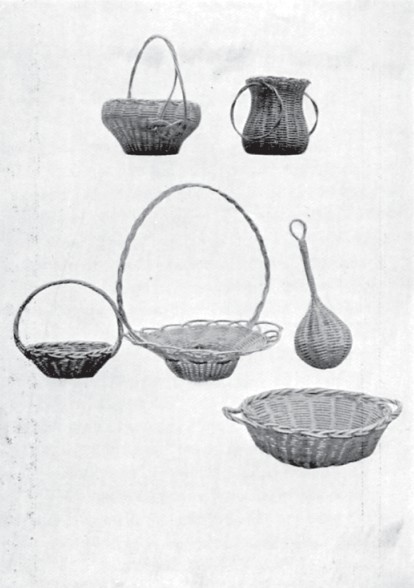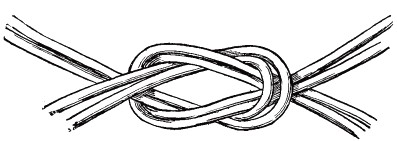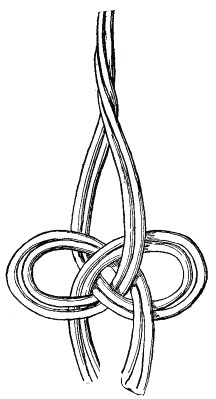| Web
and Book design,
Copyright, Kellscraft Studio 1999-2010 (Return to Web Text-ures) |
 (HOME)
|
| CHAPTER VI
HANDLES SUCH handles as are described in this chapter are simple and quite possible for the beginner to make. Others that are more elaborate will be found in the chapter on Oval Baskets.
Materials: BASKET-6 16-inch spokes of No. 4 rattan, 1 9-inch spoke of No. 4 rattan, 2 weavers of No. 2 rattan, HANDLE- 1 12-inch spoke of No. 4 rattan, 1 weaver of No. 2 rattan, A knitting needle.
Six spokes and a half are started as in the large mat and woven into a centre, which should be pressed up in the middle into a concave form like the bottom of a wine bottle. Beginners often find it hard to make a basket that will stand well. The tendency seems to be to form a rounded bottom rather than one that is perfectly flat. A bottom that is slightly concave is not so difficult to make, and answers the purpose as well as a flat one. When the bottom is two inches in diameter the spokes are wet and bent upward and woven with flaring sides. Two weavers are used, and then the basket is bound off and finished with a closed border. After wetting the spokes until they are pliable the border, which is in two rows, is begun. The first spoke is brought behind the spoke to the right of it and then out, leaving a space between the basket and the first spoke. The second spoke is brought behind the one to the right of it and then out in the same way, except that it is pressed close down upon the basket. Each spoke in turn is brought back and out until there is only one left erect. This spoke is brought behind the first spoke, out between the first and second spokes and pressed close down upon the weaving. In the second row each spoke is brought behind the succeeding one on the right and then out, making a roll on the edge of the basket with the ends outside. These ends are cut slanting, just long enough to allow each to rest on the spoke in front of it. Handle. — The knitting needle is run down beside a spoke and then drawn out leaving room to insert an end of the twelve inch spoke, which should be pressed clown at least an inch below the top of the basket. The other end of the spoke is then inserted in the same way beside a spoke exactly opposite where the first end was placed. This makes the foundation handle. The end of a pliable weaver is now inserted under the third row from the top of the basket to the left of the foundation handle and run up between the weaving. This weaver is twisted around the handle with twists about an inch and a half apart (experience will soon show that twists too near together will make an uneven handle and those too far apart one that is not firm and strong). At the opposite side of the basket the weaver is pushed in, under the third row of weaving from the top, on one side of the handle and brought out again on the other side of the handle three rows from the top, making a loop inside. The weaver is then laid close beside the first twist, and follows it across to the opposite side, where it goes in under the third row on the left of the handle and comes out on the right side. Each row of twisting must follow close beside the last and six, or at most seven, rows will cover the spoke. The weaver is fastened off by bringing it inside the basket, then out across a spoke and inside the basket again where it is cut short.
Materials: BASKET-8 24-inch spokes of No. 4 rattan, 1 13-inch spoke of No. 4 rattan, 4 1/2 weavers of No. 2 rattan. HANDLES- 2 22-inch pieces of No. 4 rattan, A knitting needle.
Strong practical handles are in keeping with the plain bowl shaped basket in the picture, which is rather like a doll's clothes basket and may be used for one. After weaving a slightly concave bottom, four inches in diameter, the spokes are wet and bent upward; rounding them over the finger as described elsewhere. The sides are gradually flared until, when four full length weavers and a half have been used, the basket is seven and a quarter inches in diameter. The top is then bound off and completed with a border as follows. In the first row, each spoke is brought back of the next one on the right and then out. In the second row, each spoke is brought back of the succeeding one on the right and then out. The third row is made by bringing each end over the next spoke on the right, and pushing it inside the basket just back of the succeeding spoke and directly above the weaving. Handles. — In making the handles the two twenty-two inch pieces of rattan are soaked until they are pliable. Then one is started in this way: After the knitting needle has been pushed down on the left of a spoke, to make way between the weavers, an end of the twenty-two inch piece of rattan is pressed down about three-quarters of an inch below the top of the weaving. The long end is brought across one spoke, not counting the one beside which it started, and down inside the basket at the left of the next spoke and just under the border; making the foundation handle which, at its widest part, should not be over an inch from the basket. The end is now brought out on the right of the spoke and twisted around the foundation handle. About three twists should bring it to the other side of the handle where it is pushed down inside the basket on the right of the spoke and out again on the left. It then twists around the handle across to the right side, where the end is cut off, leaving about an inch which is pressed down between the weavers to the right of the spoke. The second handle is made in the same way, taking care that it shall be so placed on the basket as to be exactly opposite the first one.

BASKETS WITH HANDLES The simplest handle is that on the small basket at the left of the foreground. Another simple handle is the braided one beside it. Below and to the right is a basket with small side handles. Above is the rattle with its handle of wound cane, and above that is shown the basket with large ring handles, and, most elaborate of all, the handle with interlaced ends
Materials: BASKET.-8 18-inch spokes of No. 4 rattan, 1 10-inch spoke of No. 4 rattan, 6 weavers of No. 2 rattan, 1/2 weaver of No. 2 rattan stained green. HANDLE. — 6 32-inch pieces of No. 2 rattan, A knitting needle.
A slightly concave bottom is woven, on eight and a half spokes, to a diameter of two and a half inches; when the spokes are soaked until pliable and then turned up with a very slight flare, to about an inch from the bottom. Here six pieces of No. 2 rattan thirty-two inches long are inserted, three on either side of a spoke, with the help of a knitting needle, which is first run down to make room for the ends. These six pieces are then braided into a handle (having two pieces in each strand) of the desired height. The ends are pushed down, three on each side of a spoke, directly opposite the one where the handle was started and the weaving of the basket continues. The half weaver in green is divided again and woven into one row of double weave; then the spokes are wet and bent outward, until they are so flared as almost to be horizontal. The weaver must be pushed back to make it loose enough to allow the spokes to spread. The flare continues for almost two inches, when the basket is bound off and finished with Open Border No. 2. This, if the loops are low, not over five-eighths of an inch from the weaving, will make an appropriate and pretty finish.
Materials: RATTLE. — 4 26-inch spokes of No. 3 rattan, 1 14-inch spoke of No. 3 rattan, 3 1/2 weavers of No. 2 rattan, 4 small round bells. HANDLE.-1 length of fine split cane. The spokes are bound and the weaving begun in the usual way except that from the centre the spokes are bent up and out, making a rounding top to the rattle. This flare continues until at two and a half inches from the centre the circumference is a little over ten inches. The weaver is then pulled more tightly, drawing in the spokes at first gradually and then decidedly until they almost meet, when four small bells are slipped in, and the weaving continued as far as it will go. All but one of the spokes are cut to a length of four inches from the last row of weaving, that one being left nine inches long. A length of fine cane such as is used in caning chairs, see Chapter XIII, is next wet for a few minutes and, after the spokes of the handle have been laid in proper order, it is started as close to the end of the weaving as possible, with its end turning down along the handle. The handle is held so that the spokes will not twist, and the cane is wound around it evenly and tightly, edge to edge, so that none of the rattan shows. At an inch and a quarter from the end of the handle, the long spoke is bent over into a loop and the end pressed up among the other spokes. The winding then continues to the end of the handle, and around the loop in the same way, until it is covered, when the cane is cut off leaving an end an inch long. This end is woven up the handle, over and under several rows of cane. When it has been woven in this way for about half an inch, it is bent back and run down under the cane. This finishes a rattle which a child can easily weave, and it will delight him to find he is able to make such an acceptable little gift for a baby brother or sister.
Materials: BASKET.-8 20-inch spokes of No. 3 terra cotta rattan, 1 11-inch spoke of No. 3 terra cotta rattan, 5 weavers of No. 2 terra cotta rattan. HANDLES.- 2 23-inch pieces of No. 4 rattan stained black to within two inches of each end,
A knitting needle. The fine spokes that are used in this basket make it easier to mold into curves than if it was woven on the more rigid, heavy spoke material. A terra cotta stain, see Chapter XII, is used to color the spokes and weavers of this basket, and two pieces of No 4 rattan twenty-three inches long are stained black to within two inches of each end, to form the ring shaped handles on the sides. A concave bottom, two and three-quarters inches in diameter, is woven; the spokes are then wet and the sides turned up to form a bowl shape. After the second weaver has been used the spokes are gradually drawn in by tightening the weavers, until the fifth weaver is started; when the spokes are gradually flared, until three-quarters of the fifth weaver has been used. Then they are more flared until the end of the fifth weaver is reached, when the basket is bound off. In the border each spoke is brought over the next one on the right, back of the next and then out where it is cut slanting just long enough to allow it to lie across the next spoke on the right. Ring handles are made in the same way as the rings described on page 39, only on a much larger scale, being almost three and a half inches in diameter. They are twisted so that the rings will be made of the stained part of the rattan; leaving the plain ends to be woven under and over where the rings are attached, (one on each side of the basket under the third row of weaving from the top) and afterward colored with the terra cotta stain.
Materials: BASKET.-8 20-inch spokes of No. 4 rattan, 1 11-inch spoke of No. 4 rattan, 6 weavers of No. 2 rattan. HANDLE. -1 length of No. 4 rattan.
A bottom is woven two and three-quarters inches in diameter, on eight and a half twenty-inch spokes, which are then thoroughly wet and bent upward with a slight flare. When two weavers have been used, the spokes are flared more decidedly, and when two more have been woven in this way, the spokes are drawn in while using the remaining two weavers. The edge is then bound off and finished with the simple border described in the directions for a basket with a twisted handle in the first part of the chapter. Handle. — A length of No. 4 rattan which has been soaked until pliable is cut into four pieces and then separated into pairs. These are bent into loops at about ten inches from one end of each and knotted in this way. The loops are held firmly where the short end of each comes against the long end, (making sure that the short ends are on the same sides of the loops) one in each hand of the worker, who passes one loop through the other, bringing the ends of the loop through which it passed over it, which makes the loop uppermost on one end of the knot and on the other the ends, see Fig. 13. The short ends are now crossed one under a long end and one over (as shown in Fig. 13), and brought together. The long ends are also brought together making a knot like Fig. 14. This knot is placed about half way between the top and bottom of the basket, with the long ends turning up. The short ends are finished off by weaving one to the right over and under several spokes and the other to the left. The long ends are twisted together for about twelve inches, and are then made into another knot copied from the first one for, although the process cannot be the same, it is so simple that one can easily follow its coils. This knot is placed on the opposite side of the basket from the first one and attached in the same way
FIG. 13 FIG. 14 |

